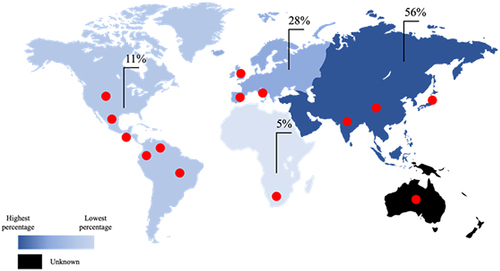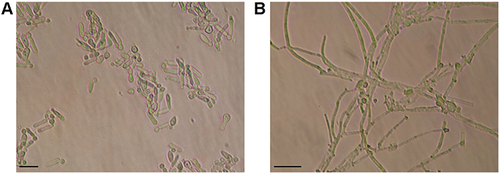Figures & data
Figure 1 Geographic distribution of Sporothrix globosa isolates. This species is mainly found in Asia (China, India, and Japan), followed by Europe (Spain, Italy, and United Kingdom), America (Brazil, United States, Venezuela, Guatemala, Colombia, and Mexico), and Africa (South Africa). The red dots indicate the countries where S. globosa has been isolated.

Figure 2 Microscopic morphology of Sporothrix globosa growing in the yeast–peptone–dextrose medium for 4 days. (A) Yeast-like cells growing at 35°C and pH 7.8, with the typical elongated cigar shape. (B) Mycelium growing at 28°C and pH 4.5, with globose conidia and branching septate hyphae. Scale bars = 10 µm.

Table 1 Genes Encoding for Putative Virulence Factors in Sporothrix globosa
Table 2 Prediction of Putative Virulence Factors in S. globosa, Based on S. schenckii and S. brasiliensis Known Virulence Factors
Figure 3 Immune response against Sporothrix globosa. Pathogen components trigger an innate immune response via dectin-1, TLR-2 and TLR-4 receptors, and macrophages and mast cells (MCs); an adaptative immune response via dendritic cells (DCs) and Tregs lymphocytes; and a humoral immune response by IgG antibodies. These responses have been observed in either Sporothrix schenckii or Sporothrix brasiliensis and are suggested for S. globosa, except those marked with*, which have already been demonstrated in S. globosa.

Table 3 Clinical Manifestations and Treatments of Sporotrichosis Caused by S. globosa
